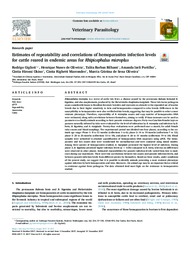Estimates of repeatability and correlations of hemoparasites infection levels for cattle reared in endemic areas for Rhipicephalus microplus.
Estimates of repeatability and correlations of hemoparasites infection levels for cattle reared in endemic areas for Rhipicephalus microplus.
Author(s): GIGLIOTI, R.; OLIVEIRA, H. N. de; BILHASSI, T. B.; PORTILHO, A. I.; OKINO, C. H.; MARCONDES, C. R.; OLIVEIRA, M. C. de S.
Summary: Rhipicephalus microplus is a vector of cattle tick fever, a disease caused by the protozoans Babesia bovisand B. bigemina, and also anaplasmosis, produced by the Rickettsiales Anaplasma marginale. These tick-borne pathogens cause considerable losses to Brazilian livestock breeders and represent an obstacle to the expanded use of taurine breeds due to their higher sensitivity to ticks and hemoparasites compared to zebu breeds. Differences in the susceptibility to hemoparasites were also verified within breeds, suggesting that may be possible to select a most resistant phenotype. Therefore, repeatability of R. microplus counts and copy number of hemoparasites DNA were estimated, along with correlations between themselves, aiming to verify if those measures can be used as parameters to classify animals according to their parasite resistance degrees. Forty-two Canchim females kept on pastures naturally infested by ticks were evaluated for the level of infestation by R. microplus and infection by B. bovis, B. bigemina, and A. marginale. Twenty-four evaluations were performed once a month, for adult female ticks counts and blood samplings. The experimental period was divided into four phases, according to the animals age range: Phase 1: 8 to 13 months (collections 1 to 6); phase 2: 14 to 19 months (collections 7 to 12); phase 3: 20 to 25 months (collections 13 to 18), and phase 4: 26 to 31 months (collections 19 to 24). Blood samples were submitted to absolute quantification of hemoparasites DNA sequences using qPCR. The hemoparasite and tick counts data were transformed for normalization and were analyzed using mixed models. Among three species of hemoparasites studied, A. marginale presented the highest level of infection. During phase 3, B. bigemina presented higher infection levels (p < 0.05) compared to B. bovis, whereas no differences were observed in other phases. Estimated repeatabilities for parasite infection levels varied from low to moderate during our experiment. There were low correlations between tick counts and parasite infection levels, and between parasite infection levels from different species by themselves. Based on these results, under conditions of the present study, we suggest that it is possible to identify animals presenting a most resistant phenotype against infection by both hemoparasites and ticks. Moreover, the animal age may be an important factor related to resistance against these pathogens. The data obtained shed more light on the resistance to hemoparasites studied.
Publication year: 2018
Types of publication: Journal article
Keywords: Tick fever, cattle, repeatability
Observation
Some of Embrapa's publications are published as ePub files. To read them, use or download one of the following free software options to your computer or mobile device. Android: Google Play Books; IOS: iBooks; Windows and Linux: Calibre.
Access other publications
Access the Agricultural Research Database (BDPA) to consult Embrapa's full library collection and records.
Visit Embrapa Bookstore to purchase books and other publications sold by Embrapa.

